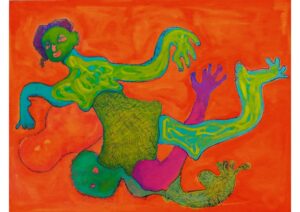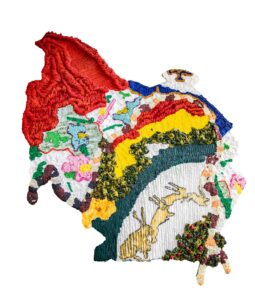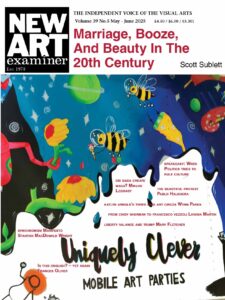personal observations on the turbo charged development of contemporary art in Africa
Valerie Kabov

oil and spray paint on canvas, 54½ x 43¼ in.38.5 x 110 cm
The past two decades marked some dramatic changes, movements and upheavals for contemporary art in Africa and its engagement with the global art community, industry and market. Like the rest of Africa, its art scene is young, ancient, dynamic, diverse, and rapidly evolving, undergoing an evolution that art scenes elsewhere would have taken generations if not centuries to develop. An accident of fate privileged me to both participate and reflect on many of these developments as an art historian, art market analyst, art critic, educator, and gallerist.
When I first arrived in Zimbabwe in 2009, its art sector, like that of many African countries, was dominated by Western cultural funders and organisations, whose major objective is promotion of their home country and language internationally – British Council, Goethe Institute, Alliance Française, Cervantes Institute, were the major hosts of exhibitions and together with embassies were sponsors of exhibitions with such laudable titles like Don Quixote and The Wall – Zimbabwean emerging artists respond to the 20th anniversary of the fall of the Berlin Wall.
But things were about to change. Unbeknown to myself, I had a glimpse at the revolution coming, with my first meaningful encounter with contemporary African art at the Venice Biennale in 2007 as part of the controversial African Pavilion in the exhibition curated by Robert Storr. Unaware of the controversy about the provenance of the collection, the African Pavilion was the only one that I remembered as being significant and transformative in the entire exhibition. It was also a recognition on a mainstream global stage of the curatorial and academic activism which had been building for more than a decade.
Publications like Nka Journal in the USA and Review Noir in France and Exhibitions like Magiciens de la Terre, Okwui Enwenzor’s Documenta 11, Johannesburg Biennale and Simon Njami’s Africa Remix and activism of Sindika Dakolo built up the ground internationally, which was waiting to be catalysed by the market into a movement capable of transforming art sectors on the continent. All publicity is good publicity, as the saying goes, Robert Storr’s African Pavilion Venice in 2007 created the noise to enable the international art market to begin to properly notice contemporary art from Africa with the milestone first edition of 1:54 in London in October 2013. This was accompanied by a ‘euphoria of arrival’, with art fairs all over the world deciding to put a spotlight on Africa and numerous survey style exhibitions with the word ‘Africa’ in the title.
This ‘arrival’ coincided with the rise of emerging contemporary art as a category globally. Overwhelmingly and attractively for the market, African artists were young, new, interesting, and cheap, low risk with high opportunity prospects. Inevitably and similarly to that of the global spotlight on other ‘emerging art scenes’ the attention from the Global North was a mixed blessing. This new interest served overwhelmingly to reinforce rather than dismantle the Global North as the fulcrum of the art world. Young African artists were being quickly picked up by Western galleries, sometimes literally relocating them to Europe and the USA for ease of access to the new market. For collectors interested in building a profile on a budget this was a boon. In 2015, for under $200,000 you could build a museum-worthy collection of the finest emerging artists from across Africa.
While the injection of capital into emerging markets can and does help build up infrastructure for domestic art scenes, it is undermined by the fact that the North remains pivotal to art interactions and the setting of art agendas. Unlike other art scenes like South America and China previously blessed with market spotlight in earlier decades with meaningful local markets and institutions for contemporary art to leverage new interest, African art scenes did not. In most ways they had to and continue to build up the entire infrastructure and ecology of their art sectors from the foundations across a continent of more than a billion people and 54 countries.
The pre-eminence of Western market influence dovetailed with the domination of foreign NGOs in the cultural funding sector in Africa. Foreign humanitarian organizations focused on developmental, humanitarian, health, social justice and frequently diplomatic and political agendas have stepped in to fill the gap left by government funding. This inevitably has meant that the broader sociological agendas of the funders take precedence over support for economic viability and artistic excellence. Conversely philanthropic efforts to support African contemporary art have also been largely ex-continental, with the largest collection of contemporary African art having been built up by Jean Pigozzi, who is also currently planning to create a museum in Europe to house his collection.

oil, printer’s ink and monotype on canvas, 38⅝ x 50¾ in.
98 x 129 cm.
The geo-politics of art economics in African contemporary art are further elaborated through the example of the 2019 Venice Biennale. When Ralph Rugoff was asked in an interview: “Are there Africans?”, referring to their participation, he answered “Yes, wonderful African artists, from Kenya, Ethiopia, Nigeria, and South Africa.” His five Africans included New York’s Julie Mehretu and L.A.’s Njedeka Akunyili Crosby who enjoy major gallery representation, with their work commanding huge prices at international auctions. Similarly stellar, Ghana’s debut pavilion in 2019 was dominated by London and New York as much as Accra, designed by London starchitect David Adjaye, with John Akomfrah (who this year is representing UK) with support of these artists’ Western gallerists – art world heavyweights – White Cube (London), Lisson Gallery (London), Jack Shainman Gallery (New York) and October Gallery (London) among other international players. Not only are they key funders of these artists but they are also the true financial beneficiaries of Ghana’s national pavilion debut in Venice. As Velthuis says: “You are considered to be successful in the art market if your prices are rising quickly… and that is exactly what … biennale enables an artist and an art dealer to do.”
Nonetheless and even as minority players in international fora, independent and internationally active galleries did begin to emerge on the continent in the second decade of the century. With support primarily of international art fairs, which were now proactively seeking out African art and African artists and art fairs on the continent like Joburg Art Fair (now Art Joburg) founded in 2010 and Cape Town Art Fair (now Investec Cape Town Art Fair) founded in 2014 and Art X Lagos, founded in 2016 they managed to gain financial viability and recognition as primary stakeholders in development of local sectors. Recognising this role and its challenges, Emerging African Art Galleries Association was founded in 2016 as a collaboration between galleries like First Floor Gallery Harare, Circle Art Gallery in Nairobi, Movart Luanda, Addis Fine Art in Addis Ababa, Afriart Gallery in Kampala to support galleries, which were usually the only international gallery in their country and whose operations necessitated that they behave as social enterprises not only representing artists but also funding production, education, providing social security and even healthcare depending on circumstances, all with no government support. The Association worked to support the members by sharing know-how, and experience as well as lobbying art fairs for more equitable treatment and recognition of the special challenges that African galleries face, when engaging internationally from shipping costs to currency transfers and visas. The strength in numbers was also an imperative, at times when in addition to the tribulations of running a gallery in a developing country context it became apparent that Western galleries had no ethical problems poaching talents identified and promoted by African galleries, with ne’er a thought to what this sabotage means for local art sectors. The extractive legacy of colonialism in Africa persisted and as attention to Africa grew in the market so did the concerns about how and where its values and narratives were being established.
Even the Financial Times took a pause from hyping the African contemporary art market to recognize that despite the euphoria internationally, n Africa, though, the picture is less rosy. Public funding is scarce. With the exception of South Africa and Nigeria, there are almost no commercial galleries to sell artists’ work and provide them with a livelihood. ” As a result, African art sectors trying to compete internationally are at a distinct disadvantage to international counterparts, in trying to build the overall ecology of art sectors on the continent without established and proactive collecting institutions.
While galleries were fighting a good fight on the ground to build up audiences and nurture artists, their remit was inadequate to build up patrimonial infrastructure that can only be done by museums and this was being recognised rapidly. In his opinion piece on the Sotheby’s first auction of African art, for the New York Times in May 2017, Chika Okeke-Agilumay, wrote:
“The sale at Sotheby’s…most likely signals the beginning of a more serious interest from Western museums, which may finally start to consider such work worthy of inclusion in their permanent collections.”
In this inexorable march to the mainstream, I am tempted to think of contemporary African art as akin to an urban neighborhood undergoing gentrification. Now that it is seen as high culture, the art and artists are gaining value, investors are jostling to get a piece of the action, and private collections are growing in Africa and around the world.
This is very good news for the African modernists who will benefit from the increased visibility. They were, some say, the postcolonial avant-garde, who set out to create new art for independent Africa during the mid-20th century. African contemporary artists have also moved beyond nationalism and are more likely to sound off about globalization and complex identities.
But the continent’s masses will be the biggest losers. They will be denied access to artworks that define the age of independence and symbolize the slow process of postcolonial recovery.”
With such a strong international market and foreign institutional collecting effort directed toward the sector, it is more than foreseeable that the vast majority of the most important works by modern and contemporary African artists will be lost to African audiences and patrimony.

silicone infused with pigment 74¾ x 65 in. 190 x 165 cm
This symbiosis between philanthropy, tourism and patrimony remains the foundation and a model for museums all over the world to this day. Globalisation and expansion of the art market over recent decades, has also made museums part of a foundational structures that establish, determine and preserve value and heritage and interact symbiotically both with the art market as well as the broader social and economic drivers of development.
Art museums, their acquisitions and exhibitions are key signals of value to the market. Inclusion in Tate Modern, MoMA, Guggenheim collection is a badge of establishment, which leads to immediate rise in market price of the artist – dead or alive.
So far market benefit of participation in Venice and inclusion has largely benefited Western4 galleries representing galleries which pick up the newly elevated artists for representation following Venice. These galleries also stand to benefit from inclusion into the Western museum collection of the African artists they represent and which signify and assure long-term value and price growth. These are the works, which will make it into textbooks and touring international exhibitions, which are sourced by reciprocal arrangements between museums increasingly defining the canon. Where will African audiences be in this?
When commentators complain about African contemporary art being undervalued, one of the things that they are in fact commenting on is that these artists have not been daubed as masters by the powers that be. It is unequivocal that reputations have been built and consolidated by inclusion in museum collections.
While celebrating the not a moment too soon recognition of masters like Ibrahim El-Salahi and El Anatsui by inclusion in the collections of major museums like the Tate and MoMA, Africans should also be mourning that they are ceding authority about the making of the African art canon to third parties.
The momentum and imperative for establishing art institutions crystalised in 2017 with the opening of Zeitz MoCA in Cape Town, which was quickly followed by a number of institutions elsewhere like Macaal in Marrakech, Shyllon Museum in Lagos, Norval Foundation in Cape Town and Palais de Lome in Togo. Given that Western Europe and North America have more than 30,000 museums to a population of 1 billion and for a similar population base, Africa has just over 800, the challenge of establishing the project establishing authoritative and authentic representation of African art both historically and contemporaneously is immense.
And yet it is a true key to genuine ownership of history, legacy, value creation and retention of cultural heritage for future generations; providing access to Africans to the best examples of contemporary art and the value that this engenders. Only the locally founded collecting institutions are in a position to at least try and assure democracy and plurality of representation.
It is equally unequivocal that building up local institutions of the quality and capacity to adequately address these needs is an enormous challenge. While founding fathers of newly independent African nations like Kwame Nkrumah and Sekou Toure, recognized the importance of cultural nationalism, art could not and has not taken priority above health care, education and core infrastructure like roads and building up industry, the urgent needs of young nations.
Speaking to the African Art Report in 2014 about his collection, Sindika Dokolo said:
“The real added value of an African collection of art is to expose the African audience to its own contemporary creation. It is a moral and political responsibility and an effort must be made so that our continent is more integrated in the art world circuits. Therefore, I decided early on that my collection would always be available for free for any museum around the world who would be interested in hosting an exhibition. However, I have one demand in that the museum has the obligation to organize the same exhibition in an African country of its choice. We cannot just accept that African art will never be seen in Africa because our continent is still poor and focused on its primordial needs.”
However we live at a moment of acceleration of history.
Over the past decade, the art market has been undergoing turbulent changes. Globalisation and emerging art markets, art as an asset class, social media, art fairs, emergence of multi-national gallery models and rise of private museums boom. Examined closed, many of these changes are driven at least in part by collectors and new business-conscious collectors are engaging with the market and artists. While criticisms of the monetisation and productisation of art abound, one development in particular has been emerging as a positive signifier – emergence of activist collectors in a patron capacity.
Reporting for New York Times in 2017, Jennifer Miller reports on:
“a shift in how some arts enthusiasts, from wealthy individuals to grant-making foundations, are relating to creators. They are moving away from merely collecting and consuming art and toward a model reminiscent of the Renaissance, when royal houses provided room, board, materials and important professional connections to talented artists of the day.
Patrons of the 21st century are far less politically motivated than the Medici family and their ilk, and they generally don’t house artists in their lavish estates or command them to paint frescoes. But just like the patrons of old, they are giving creators a pathway to success and economic stability, providing living expenses, supplies, pep talks and more.”
Explanations can be many from the drastic cuts in government cultural funding to changes in the way art is produced and the backgrounds of collectors, Rose Lee Goldberg, the South African born founder of Performa, “believes today’s patrons are similar to the “angel investors” of tech. “You see that something has potential to grow and you want to support that incubation period,”
While many default to comparisons to the Medici Renaissance patronage, the idea of artist patronage is far from uniquely European.
Speaking about re-emergence of patronage in the context of Chinese and Hong Kong contemporary art Chin Chin Teoh, co-director of the MILL Foundation, a non-profit arts and cultural organisation, qualifies the difference between a collector and a patron: “we like to classify a patron as the sort to have a direct relationship with the artist. There is a direct dialogue between the artist and patron, so the relationship is mutually negotiable,”
In many ways while the impetus to support art at present has been catalysed by international attention, there is an inevitable transformation that happens, when people look at art that represents them in their own context. The magic of authenticity.
Africa is the youngest continent, with energy and capacity to invent and reinvent, leap-frog and challenge. In art in particular major gaps in infrastructure and lack of established systems and institutions and resourcing is an opportunity for activists and advocates to do things on their own terms.

